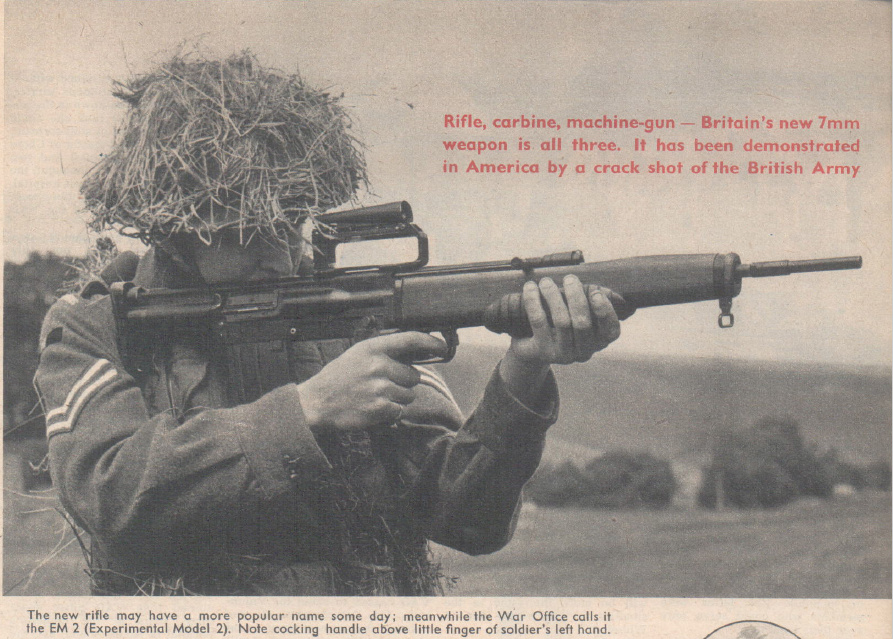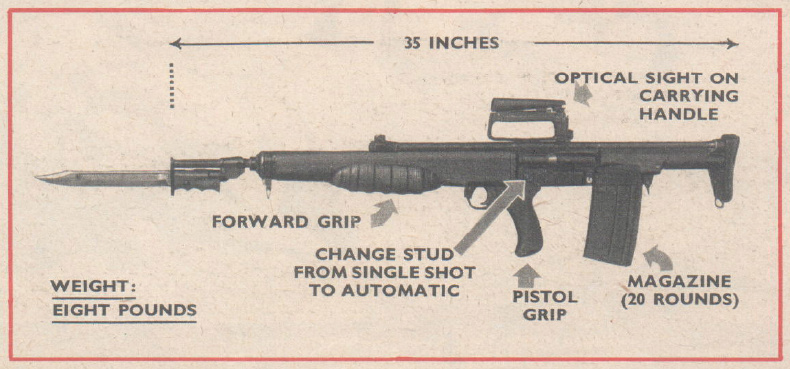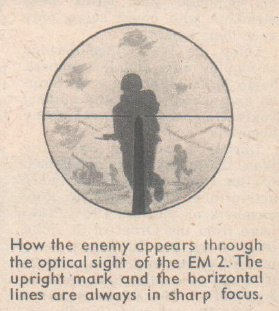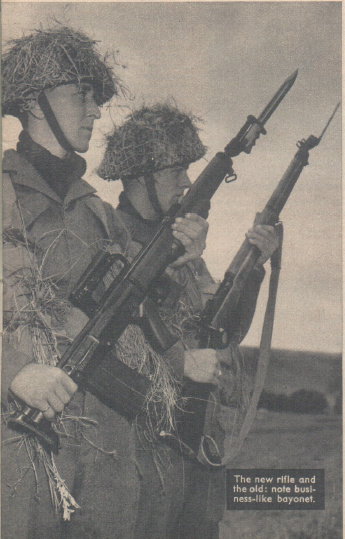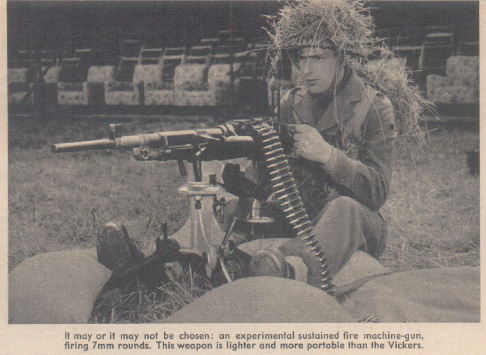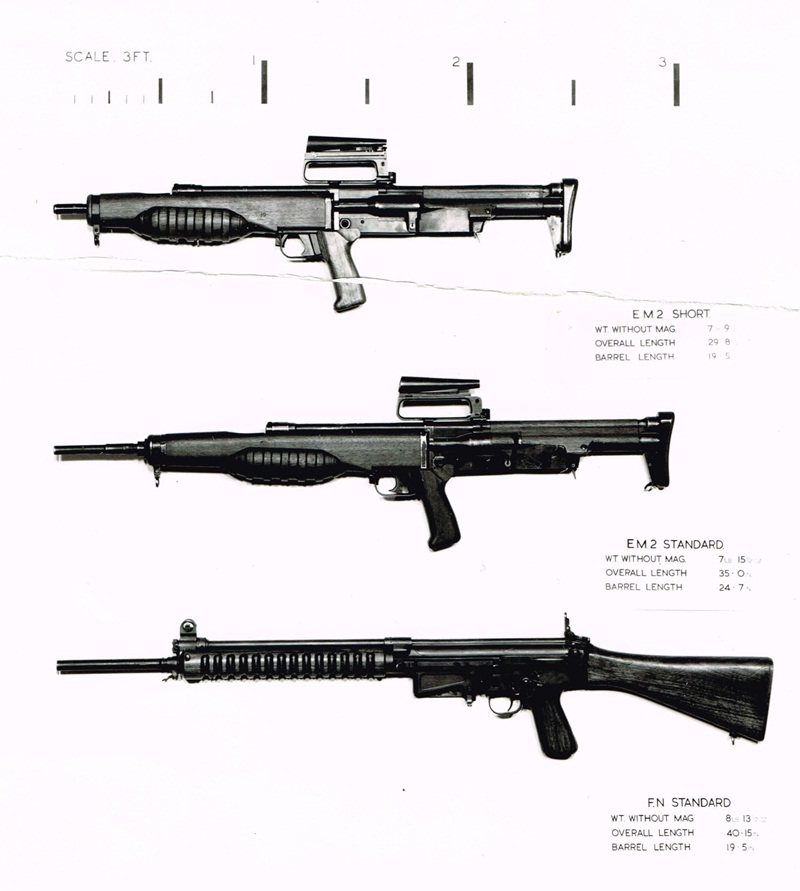280/30 FN FAL Rifle
The following is an excellent article taken from historyofwar.org:
(Antill, P. (29 July 2009), The EM-2 (Rifle No. 9, Mk 1): Britain’s Original Bullpup Rifle, http://www.historyofwar.org/articles/weapons_EM-2_rifle.html)
Background
At the end of World War II, the British remained one of the few major powers that had yet to introduce a self-loading rifle into service. The Soviets had fielded the Simonov AVS36 in 1936 but had failed to trial it properly with the result all sorts of problems in reliability occurred in the field. Further development resulted in the Tokarev SVT38 and SVT40, both of which continued the 7.62x54R calibre. In 1943, they also developed the 7.62x39mm intermediate cartridge and the following year brought out the Simonov SKS carbine to use it. The USA had adopted the M1 Garand in 1936 and during the war, the Germans had developed the FG42 paratroop rifle, the G41 and G43 semi-automatic rifles as well as the revolutionary StG44 (also known as the MP44). The British Army meanwhile, were still using the No. 4 Lee Enfield bolt-action rifle in .303 calibre, a rifle which, tried and tested though it was, traced its roots back to the late 19th Century. Experience of infantry combat during the two world wars, questioned the need for infantry to be armed with weapons that were chambered with cartridges that were accurate out to 2,000 yards. “In fact, despite the evidence that most shooting during WW1 was at short range, armies continued to show an interest in full-power rifle/MG rounds.” This experience from World War I was reinforced by events during World War II, where “it was obvious that the modern warfare will require the infantry to be armed with light, selective fire weapon with effective range of fire much longer than of submachine gun, but shorter than of conventional semi-automatic or bolt-action rifles.”
A New Calibre is Found
The concept of a bullpup service rifle for the British Army actually goes back to a decision taken in late 1945, at the very end of the war. The Ministry of Supply set up a “Small Arms Ideal Calibre” Panel to determine the optimum cartridge for a lightweight self-loading rifle. A great deal of experimentation and testing took place, primarily of calibres between .250 and .270 (approximately 6.35 to 6.8mm), undertaken at the Armament Design Establishment, Enfield under Dr Richard Beeching, the Deputy Chief Engineer. The panel reported in March 1947, recommending the further development of two different designs. The first, appearing in November 1947, was in .270 calibre (6.8x46mm) with a steel-cored 100gn bullet travelling at between 2,750 and 2,800fps (approximately 840 to 850m/s). This round retained 81 ft lbs of energy (109j) at 2,000 yards (1,830m) with 60 ft lbs of energy (80j) reportedly being necessary to injure an unprotected human being. The second was in .276 calibre (7x43mm), later re-designated as .280 to avoid any confusion with earlier ammunition, such as the American .276 Pedersen and .276 Enfield P13, both of which had been considered as potential new rifle calibres for their respective countries, in 1913 and 1932 respectively. Indeed, the .276 Pedersen round may well have been the cartridge chambered in the M1 Garand, had it not been for the intervention of General Douglas MacArthur. This round was tested with a number of bullets weighing between 130 and 140 grains (8.4 to 9g), with velocities between 2,330 and 2,450fps (710 to 747 m/s). The 130gn / 2,450fps combination had a retained energy of 100 ft lbs (135j) at 2,000 yards (1,830m). In time, a combination entailing a Belgian-designed 140gn (9g) bullet fired at a velocity of 2,415fps (736m/s) was chosen for further development and in November 1948, the .270 calibre round was dropped and attention focused on the .280 cartridge. The .280 calibre was slightly larger than originally intended but was selected in order to try and meet the American desire for good long-range performance. In line with this, and with an eye to the possibility of it being standardised within NATO, the original case rim diameter was enlarged slightly to more closely match that of the .30-06 round in order that it be easier to re-barrel existing weapons, with the result that the designation was changed to .280/30.
A New Rifle is Needed
World War II impacted on British small arms design in two ways. Firstly, in terms of actual small arms design, there was very little in terms of an indigenous knowledge / skill base for small arms design up until the outbreak of war. “There was very little ‘know how’ in Great Britain before the war. Practically all small arms were purchased abroad and as the Germans over-ran Europe, so a number of European gun designers managed to escape and come to England and join the Ministry.” Secondly, the war had seen the capture of a large number of German weapons, many of whose features were incorporated into British designs. It was first thought that these new designs were ‘ersatz’ or cheap items due to the large amount of sheet metal stampings used but closer examination proved that this was not the case. In the latter stages of the war, the Germans had suffered shortages of expensive alloys and so weapon designers had been forced to come up with equipment that used normal carbon steels wherever possible. The Germans had eventually mastered the art of mass production during wartime that meant that they could produce items at a price far cheaper than most of the rest of the world was paying (who were using the time-consuming, expensive method of extensively machined metal forgings) but without any loss in quality.
Two different weapons influenced the post-war bullpup designs from the Armament Design Establishment, Enfield. The first was a sniper rifle, also designed at ADE Enfield, which was intended to be a solution to the problem of snipers being visually spotted when operating the bolt on the No. 4 Lee Enfield rifle. Three designs were produced but only one prototype was built, in 7.92x57mm calibre. The second weapon became known as the EM-3 or Hall rifle and was developed from a design solution put forward to a problem set on the 8th SAT(War) Course at RMCS Shrivenham in 1944. The design solution, put forward by Major J E M Hall of the Australian Army, was favourably received by the staff at RMCS and additional development was undertaken to the point where a patent, No. 589394 was granted to Major Hall by the British Patent Office. It is interesting as it was even shorter than the Enfield designs under development, was completely sealed against the external environment and featured over-the-shoulder ejection, thus it was able to be fired either left or right-handed. Both of these had an impact on the subsequent designs coming out of ADE Enfield.
 EM-1 Korsac Rifle
EM-1 Korsac Rifle
Four design teams were formed at Enfield, under the overall project leadership of Noel Kent-Lemon. The first of the bullpup designs was the EM-1 or Korsac rifle which originated with the Polish design team based at Cheshunt, Hertfordshire, headed by Roman Korsac until his retirement when Captain Januszewski (who later changed his name to Stefan Kenneth Janson) took over. This weapon was mainly used to investigate the feasibility of the bullpup layout in this sort of weapon and owed its design to German weapons produced during World War II, most notably the FG42 paratroop rifle.
The initial FG42s were made by Heinrich Krieghoff Waffenfabrik of Suhl and first used in action during the rescue of Mussolini by German commandos led by Otto Skorzeny in September 1943. The design was such that the rifle used the same 7.92x57mm round as the regular Mauser Kar98k but was shorter and lighter. This was done by moving the magazine up to the left-hand side of the receiver and onto the same vertical axis as the trigger and pistol grip, along with moving a hollow, recoil-cushioned butt forward so that it surrounded the rear of the receiver. In addition to the Korsac rifle, an experimental GPMG known as the Taden gun was developed, which would replace the Bren LMG and the Vickers heavy machinegun, while the Korsac rifle would replace the 9mm Sten SMG and .303 Lee Enfield rifle.
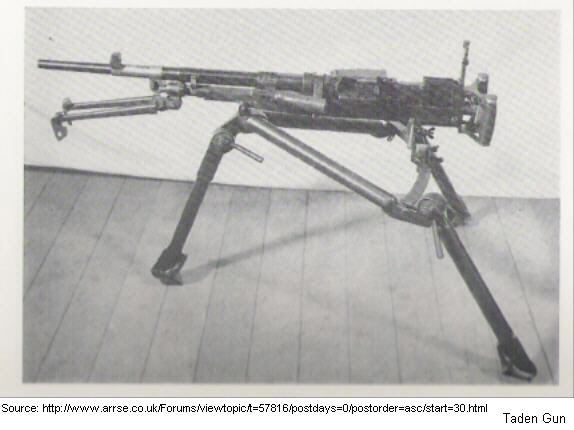
EM-1 Thorpe Rifle
The Korsac rifle design was moved to museum status on 25 September 1947. It was succeeded by a new design, from a team led by Stanley Thorpe that ran in parallel with a second design from the team led by Stefan Janson. This new EM-1 was therefore also known as the Thorpe rifle. It was a light automatic rifle that shared characteristics with the Mauser Gerät 06 No. 2 and a construction based upon the sheet metal stampings method pioneered by the Germans.
 EM-1 Thorpe Rifle
EM-1 Thorpe Rifle
Mauser Gerät 06 No. 2
The Mauser Gerät 06 No. 2 was a prototype weapon, itself the forerunner of the Sturmgewehr 45 (StG45), a replacement for the StG44 (also known as the MP43 and MP44) which had come into service with the Wehrmacht in late 1943. The StG45 was intended to be even simpler than the StG44 and therefore easier and cheaper to manufacture (45 Reichsmarks compared to 70 Reichsmarks). The first Thorpe rifle was proofed at Enfield on the 19 and 20 December 1949 to a pressure of 23 tons with a 130 grain .280 calibre bullet with a mild steel core and a charge weight of 30.1 grains. The design was eventually dropped due to problems with the stamped sheet steel used in the weapon’s construction, the complexity of the weapon, the difficulties of field stripping the weapon and the advanced state of the EM-2, also known as the Janson rifle.
 Mauser Gerät 06 No. 2
Mauser Gerät 06 No. 2
This design employed the standard method of machining and finishing forged steel as used in the FG42 and Korsac rifle. It also used characteristics found in the Gewehr 43 (or Karabiner 43), a German semi-automatic rifle that was itself inspired by the Tokarev SVT40 semi-automatic rifle, including a gas operating system and pivoting locking lugs. The Janson rifle kept all these features as well as lessons from the Korsac rifle to include an identical butt plate retainer and release, the same basic bullpup layout, a similar receiver design and methods of manufacture and an identical cocking handle location.
Towards the end of World War II, the United States had also been considering the replacement of its venerable .30-06 cartridge and the weapons that used it, looking to develop what was in essence, a selective-fire, lightweight rifle. They were therefore after a rifle that was small, handy and capable of selective fire just like the .30 M2 carbine but with the stopping power of the M1 Garand and having a weight of around 7lbs (3.2kg). Perhaps optimistically, the new rifle was required to replace both the M1 Garand and the Browning Automatic Rifle in .30-06 calibre (7.62x63mm), both the M1 and M2 carbines in .30 calibre (7.62x33mm) and the M3 SMG in .45 ACP calibre (11.5x23mm). The new lightweight rifle was expected to fire a round that was shorter than the .30-06 cartridge but still retained satisfactory performance at longer range so it could entirely replace the older cartridge – “a stopping and wounding power which shall not be less than that of the standard calibre .30 ammunition [7.62×63] fired from the M1 at ranges of 400, 800, 1,200 and 2,000 yards [up to 1,830m].” Once again, a great deal of experimentation followed but against all logic, the Americans decided to stay with the .30 calibre. Ultimately, they reached the point where they had a length of 51mm instead of 63mm but with very similar performance to the .30-06 round (made possible by modern propellants) and therefore very similar recoil. The new selective fire lightweight rifle would prove uncontrollable in full automatic fire, something proved years before the introduction of the M14. However it must be noted that American opinion on this matter was far from homogenous.
Trialling the Contenders
The EM-2 and FN lightweight rifle in .280 calibre (the Belgians were enthusiastic supporters of the British concept, along with the Canadians) were tested in the UK from late 1948 to late 1949 and then taken to the USA to begin trials, in competition with the American T25 experimental rifle. First to commence were the engineering trials at the Aberdeen Proving Ground between March and May 1950, followed by troop trials at Fort Benning, Georgia in front of the US Army Infantry Board between May and November 1950. After firing almost 57,000 rounds of .280 ammunition, the EM-2 had suffered stoppage rates of less than 5 rounds per 1,000 for automatic fire and only 3.4 rounds per 1,000 for semi-automatic fire. The M1 Garand, used as a control weapon, suffered stoppages of 3.8 rounds per 1,000 firing on semi-automatic only. The T25 was chambered for the original T65 cartridge (7.62x47mm) which was still in the early stages of development but eventually became the 7.62x51mm NATO round. At Fort Benning, the Trials Board reported that “the T65 Cal .30 is not satisfactory because of its excessive recoil, blast, flash and smoke. That the Cal .280 is not satisfactory because of its relatively high trajectory. That of the two basic types of rounds submitted for the test the British calibre .280 is preferred.” The actual findings of the tests showed that while the trajectory of the T65 was somewhat flatter and produced greater wounding at ranges of up to 1,000 yards (900m), the British .280 cartridge became more effective than the T65 at the longer distances due to is superior ballistic coefficient. At 1,000 yards, the British round could penetrate body armour seventy percent of the time, compared to the T65 that achieved sixty percent. The British round was also superior in terms of the collateral effects of shooting, that is, blast, recoil, flash and smoke. In addition, the T25 was found to slightly more accurate and achieved more hits per minute when fired from a bipod, but the EM-2 was vastly superior when fired from the shoulder.
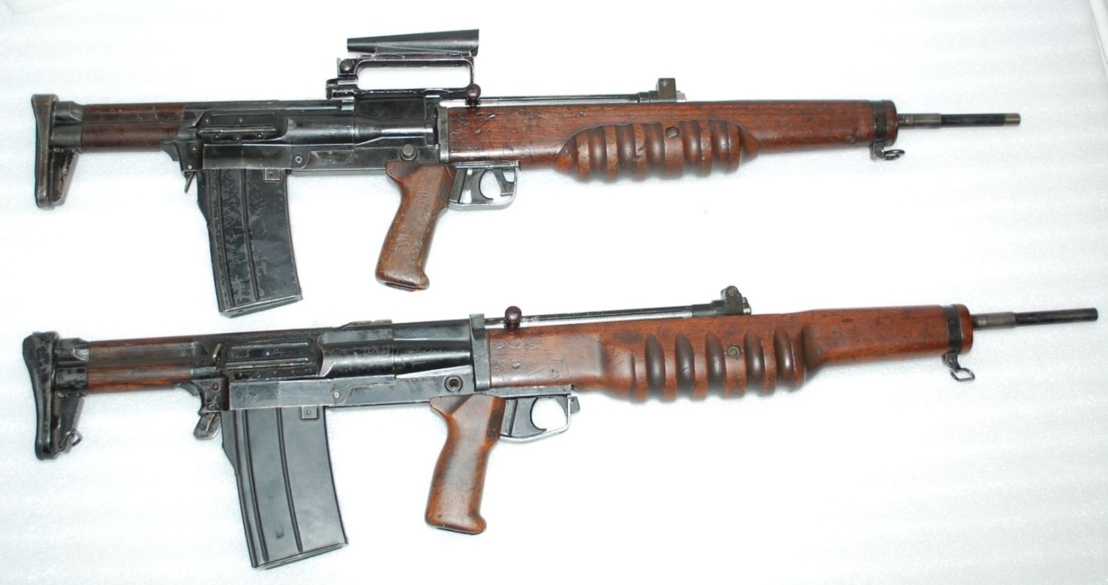 Enfield EM-2 Rifle
Enfield EM-2 Rifle
A Shock Result . . . ?
Overall, the British design team had achieved all that they had hoped to. In spite of being the most accurate and reliable rifle in the trial, and the Trials Board’s recommendations to focus development on the .280 round, the decision was ultimately rejected by the US Army Chief of Staff, General J Lawton Collins. This was because the clear preference of the US Ordnance Department (who considered the .280 cartridge underpowered) as well as the wider American political establishment and military-industrial complex, was for a full-power .30 calibre cartridge of American origin, and so having a domestically designed contender meant that the US Ordnance Board considered all other designs, especially when they were foreign ones, to be virtually irrelevant. “They accepted the concept of standardisation, but only if their round was the one to be standardised. There was thus little hope of persuading them to re-tool to a new calibre, with all the attendant costs that would be incurred, especially if it was of foreign design.” The British were aghast at the decision and felt the trials at the Aberdeen Proving Ground and Fort Benning should have settled the matter decisively and so were determined not to give up that easily. The British focused their efforts on overcoming the American objections by producing more powerful versions of the .280 round. With the support of both Belgium and Canada, they first increased the charge in the 43mm case and added a 140gn bullet to produce a velocity of 2,550fps (777m/s) to overcome the trajectory problem and the complaints that arctic conditions reduced performance to an unacceptable level. This increased the energy available at 2,000 yards to 126 ft lbs (170j). The Americans would not consider however, any reductions from their preferred calibre of .30 and so the British unilaterally adopted the EM-2 rifle and the .280/30 cartridge in August 1951 following the decision in April of that year by the UK’s Minister of Defence, Emanuel Shinwell.
The Storm Breaks
This decision provoked immediate alarm in the rest of NATO. The issue was discussed at length at a meeting convened by the Canadian Defence Minister, Brooke Claxton, along with the defence ministers of Britain, France and the USA, at the Pentagon on 2 August 1951. By this time, a General Election in the UK had led to a change of government, with the Conservatives under Winston Churchill replacing Labour under Clement Atlee. At the meeting in the Pentagon it was made clear that the .280/30 (7mm) cartridge for which the EM-2 was chambered would never be accepted by the other members of NATO and so in the interests of the majority, it was agreed that only weapons then currently in production, would remain so until NATO decided on a new round to be adopted. However, it was clear that “the US was in a position to dictate to an almost bankrupt Europe the path that must be taken”and so despite the vision Shinwell had for the British Army to have had a shorter, lighter and more accurate replacement for the 9mm SMG and .303 rifle, Churchill, on being returned to power, understood what was being hinted at by the USA. Shinwell proved that he was ready to promote new technology but Churchill was a realist. The West’s relations with the Soviet Union and its Eastern Bloc allies were becoming more strained by the day and the UK could not take such a huge risk as to unilaterally introduce a new service rifle, especially one whose cartridge was not going to be adopted by any other member of the Alliance. Any serious crisis and breakdown in relations with the USSR could mean that British troops would be deployed to reinforce those already in Europe, armed with an unproven weapon and firing a non-standard round, making re-supply from friendly forces difficult if not impossible, meaning that any major shortfalls in the availability of ammunition could be disastrous.
In a move that was seen by many at the time and since, as bowing to American pressure to maintain good relations within the Atlantic Alliance, Churchill agreed, in early 1952, to rescind Shinwell’s decision, reportedly after a meeting between Churchill and Truman on 9 January. Despite this, Britain, Belgium and Canada came together to form what became known as the ‘BBC’ Committee to have a try at producing a 7mm cartridge that would be acceptable to NATO (i.e. the Americans). A number of different cartridge lengths were tried, with such names as ‘Optimum’ (the bullet seated less deeply), ‘High Velocity’ (7×49.5mm), Compromise’ (7x51mm) and ‘Second Optimum’ (7×49.15mm). The final variant was a 7.62x51mm round necked-down to 7mm. All this was to no avail and by the end of 1953, the BBC Committee caved in to American pressure and the 7.62x51mm cartridge was formally adopted as the standard NATO round on 1 February 1954. The EM-2 was briefly re-chambered for the new round but as with the enlarged .280 cartridges, the recoil and blast effects had increased to such a level as to be completely contrary to the original concept and it was almost impossible to control the weapon when firing in full automatic. The .280 cartridge and EM-2 concept was shelved and the design team disbanded, the only practical result being a cartridge called ‘7mm Medium’ which saw service in an FN FAL variant that was sold to Venezuela.
In the Background . . .
That however, is not quite the whole story. Even as the trials were starting, two American research projects were begun, that would come to fundamentally different conclusions than that of the US Ordnance Board. The first originated with the Operations Research Office (ORO – formerly the General Research Office) and called Project BALANCE. It was a spin off from Project ALCLAD which looked at how to improve personal body armour. The head of the division, Norman Hitchman, reasoned that in order to improve body armour, one needed to look at how wounds were created and where they tended to occur. A mathematical analysis of over three million casualty reports from both world wars was entered into ORO’s computers along with reports from Korea, which led to the creation of Project BALANCE, a theoretical study of the use of infantry rifles in combat. The second, started in early 1950 when the Ballistic Research Laboratory (BRL), based at the Aberdeen Proving Grounds was asked by Colonel René R Studler, the Chief of Small Arms Research and Development in the US Army Ordnance Department, to look at the effectiveness of the infantry combat rifle. Studler was attempting to buttress his own views in supporting the adoption of a full-power rifle cartridge and distrusted ORO’s civilians who he thought was starting to infringe upon his area of responsibility.
Both reports were completed in 1952. In March, BRL’s Donald Hall published An Effectiveness Study of the Infantry Rifle, outlining that a high-velocity, smaller calibre bullet could give just as good or better hit probability than a slower, larger calibre bullet owing to its flatter trajectory and that at short range, the smaller calibre might even outperform the larger one. In addition, due to the decrease in individual cartridge weight, an infantryman could also carry a larger number of small calibre rounds and therefore in theory, could inflict a greater number of casualties than an infantryman carrying larger calibre rounds. In June, Hitchman’s report entitled Operational Requirements for an Infantry Hand Weapon was published, much to the discomfort of many in the Ordnance Department. The report analysed data from combat records in World War II and the conflict in Korea (interviews were conducted with over 600 personnel) where it found that it was rare for rifles to be used against targets at ranges greater than 300 yards, and that marksmanship dropped quickly beyond 100 yards due to such factors as eyesight, the terrain and visibility. The average distance for bullets hitting from aimed shots was between seventy-five and 100 yards, while eighty percent of effective rifle and LMG fire occurred at ranges that were less than 200 yards and ninety percent at ranges under 300 yards. Hits at ranges greater than 300 yards were considered to be so infrequent that they were considered to be on a par with the chances of being hit by shrapnel from an artillery shell. As such, a small calibre weapon that provided good single-shot characteristics up to 300 yards and controllable ‘pattern-dispersion’ at longer ranges might double the chances of hitting over a single shot from an M1 Garand. On top of that, the test results for the treasured .30 calibre Lightweight Rifle, duly reported by the ORO, proved to be a major disappointment for the Ordnance Department. The tests consisted of firing controlled, five-round bursts at silhouette targets held in a frame that was 6ft (1.8m) square. In repeated tests, conducted at no more than 100 yards (90m), only a single bullet from each burst even hit the frame, let alone the target while at 50 yards (45m), only one bullet hit the target, that being the first bullet fired with the remainder firing high as the muzzle rose under the force of the recoil. “The inevitable conclusions of the Hitchman Report were that the .30 cal Light Rifle cartridge was vastly overpowered for its purpose and that fully-automatic fire with a powerful rifle was a waste of time and ammunition.”
Conclusion
The demise of the .280 chambered EM-2 rifle was ultimately due, not to technical reasons, for it was a “well balanced and laid out rifle, with comfortable controls, accurate and reliable . . . had it been put into service, the British troops could have a first class assault rifle prior to 1960” but political ones, both national and international. It fell victim, despite the recommendations of the Trials Board overseeing the tests at Aberdeen Proving Ground and Fort Benning, as well as two official reports, firstly to American domestic sensitivities from the military, industrial and political establishments and their preference for a domestic .30 calibre cartridge and rifle, quickly followed by the United States’ ability to put pressure on a bankrupt Western Europe to accept their solution, the overpowered 7.62x51mm round. “The high-handed approach to the idea by the Americans, the insistence on a round of their design, and a .30-calbre full-powered one, did not sit well with the other countries. But many of them were already armed with American weapons from World War II, and . . . their economies were very dependent on the billions of dollars that the United States was spending as part of the Marshall Plan to rebuild Europe.” Although the 7.62x51mm round was seen as a compromise between the British .280/30 cartridge (a true intermediate round) and its most direct predecessor, the .30-06 round (a full power rifle cartridge), it was merely a slightly shortened .30-06 that maintained similar ballistic qualities to its parent and as such represented no sort of advance on a fifty-year old design. “As a result, it falls between two stools, being less powerful than the rounds it replaced but too powerful to be a practical assault rifle round.” It also caused a political storm in the UK and had an impact on outlook of the UK Armed Forces. “Psychologically, the frame of mind of the British officer class had been damaged by “the EM-2 experience”, wherein this audacious “bullpup” rifle (which was, not only in their opinion, an excellent rifle; embodying optimum weapon characteristics and firing a thoroughly well-researched “Ideal Calibre” cartridge), was betrayed by politicians who were seen as bowing to pressure from the US Army Ordnance.”
The Tide of History
Frustratingly, for the proponents of the smaller calibre assault rifle, continuing trials in the USA suggested that the new AR-15 assault rifle developed by Eugene Stoner and chambered for 5.56x45mm (.223) ammunition was superior to the M-14, the rifle chosen to chamber the 7.62x51mm cartridge. The Ordnance Department recommended that development should be pursued with a view to replacing the 7.62mm rifle, which had only been formally adopted for service two years before. The US Air Force ordered the rifle in 1960 to replace the M2 Carbine and formerly adopted it in 1964, with the US Army finally following suit in February 1967. The British .280 cartridge proved to be far ahead of its time with the USA replacing the M14 with the M16A1 in most combat units by the end of the decade, especially those in Vietnam. The M16A1 was designed to use the M193 cartridge but this has been the subject of considerable controversy over its apparent lack of stopping power, reported by troops in Vietnam. These problems influenced the next set of NATO Standardisation Trials as, to few people’s surprise, the 5.56x45mm cartridge was chosen, but it was decided that the Alliance would adopt the Belgian SS109 cartridge as this had a 62gn bullet, contained a hard steel element near the tip and had better long-range performance. The USA too adopted this variant, as the M855. However, these problems of lethality have never really disappeared, for if “the 7.62mm was overpowered, the 5.56 was distinctly underpowered for military use, being essentially a small game (“varmint”) cartridge. In fact, the 5.56x45mm is illegal for deer hunting in many areas of the US”.
This lack of lethality has been evidenced in the conflicts in Iraq and Afghanistan, especially for those troops using the M4 and M4A1 carbines, which in this case primarily equates to US Special Forces. The problem seems to relate to the difference in velocity that the SS109 round leaves the M4 (792m/s), as compared to the standard M16 (884m/s). The SS109 is most lethal when it strikes a target at a velocity of 731m/s or greater, after which the bullet starts to tumble and fragments along the cannelure causing a miniature explosion, enhancing the size of the wound cavity. For a standard M16, the range at which the SS109 round drops below 731m/s is around 200m, as opposed to the M4, where this occurs at a range of less than 100m. This has led the USA to procure a new 5.56x45mm cartridge, the Mk 262, Mod 0 and Mod 1, which fires a 77gn (5g) bullet at 832m/s from a 16in barrel, while fragmenting at velocities as low as 610m/s, meaning it will have enhanced lethality at about 300m for a 16in barrel and 250m for the 14.5in (M4) barrel.
Some Special Forces were sceptical as to whether any 5.56x45mm could fulfil what they were looking for, so began to look at other options. Two such calibres were 6.8x43mm Remington SPC and 6.5x38mm Grendel, both of which had ballistic properties broadly similar to the British .280/30. While these programmes were shelved due to the introduction of the Mk 262, the USA is again looking at its future requirements in the Lightweight Small Arms Technologies (LSAT) development programme which aims to develop a next generation LMG to replace the 5.56mm M249 (FN Minimi) with a weapon that is much lighter. The initial calibre and ballistics have been chosen to match the 5.56x45mm SS109 round for comparison purposes but it is also hoped that the programme may lead to the development of both a rifle and machinegun using an intermediate calibre round that could replace both the 5.56x45mm and 7.62x51mm. One candidate is a 6.5mm cartridge, firing a 120 grain bullet which approximates to the effectiveness of 7.62x51mm at 1,000 yards. “Is it possible to achieve a suitable common cartridge? The evidence suggests strongly that it is. The British aimed to do this with the 7×43 cartridge half a century ago, and by all accounts succeeded admirably.” Need any more be said?
























Bullet types:
a. Salmon/Pink tip – Semi AP Type C
b. Blue tip – AP
c. Green tip – Drill – case was filled with lead balls and coal dust with a cardboard disk seal at the base
d. Red tip – Observation
e. Black Tip – AP-I
f. Brown tip – Semi AP Type AA
g. GM Yellow tip – mild steel core Type B
h. White tip – Tracer
i. CNCS yellow tip (Type S French)
j. Purple tip – AP-I (case with RG 70 IZ headstamp)
During 1949 the British, together with the Belgians at the FN factory did further trials with the Belgian engineers suggesting to use the CNCS 7mm Mauser bullet (Type S-12 bullet) that provided better ballistics.








These photos below are all from a write-up about the EM-2 in the October 1951 issue of SOLDIER Magazine:
